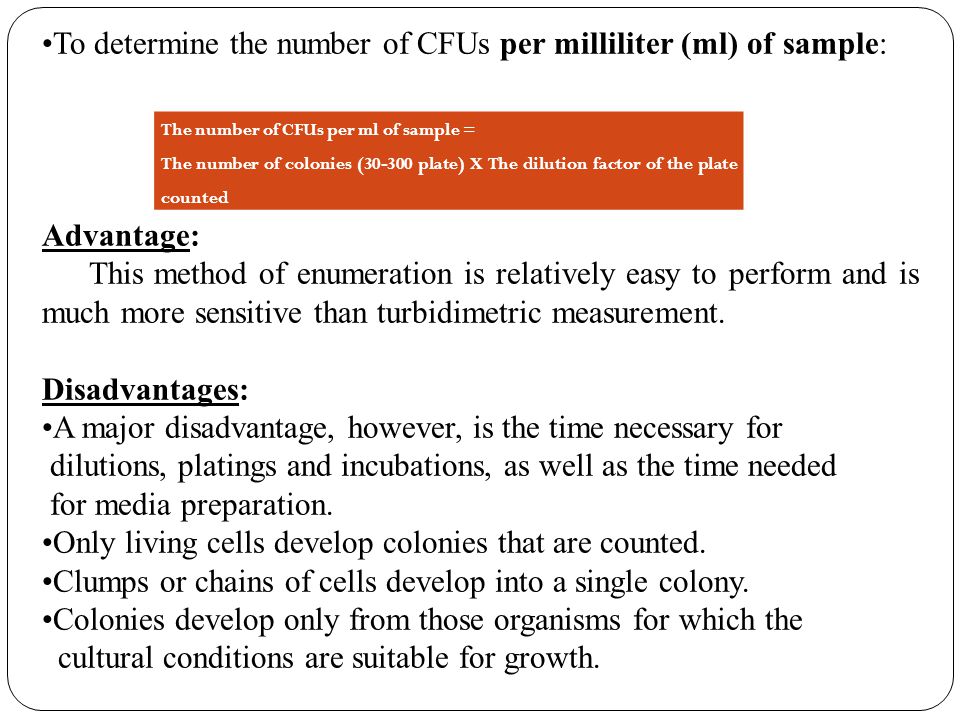What Are Some Advantages And Disadvantages Of The Serial Dilution Agar Plate Te
Some techniques operate and are applicable to a wide range of concentrations of the species in question. Preparing a series of solutions to generate a calibration curve of instrument response is fairly labor intensive and provides many points where errors may occur. Advantages of “Serial Dilutions”. 'The Advantages of Serial Dilution.
Overview Source: Laboratories of Dr. Ian Pepper and Dr. Charles Gerba - Arizona University Demonstrating Authors: Bradley Schmitz and Luisa Ikner Surface soils are a heterogeneous mixture of inorganic and organic particles that combine together to form secondary aggregates. 
Within and between the aggregates are voids or pores that visually contain both air and water. These conditions create an ideal ecosystem for bacteria, so all soils contain vast populations of bacteria, usually over 1 million per gram of soil. Bacteria are the simplest of microorganisms, known as prokaryotes. Within this prokaryotic group, there are the filamentous microbes known as actinomycetes. Actinomycetes are actually bacteria, but they are frequently considered to be a unique group within the classification of bacteria because of their filamentous structure, which consists of multiple cells strung together to form hyphae. This experiment uses glycerol case media that select for actinomycete colonies, during dilution and plating. Typically, actinomycetes are approximately 10% of the total bacterial population.
Bacteria and actinomycetes are found in every environment on Earth, but the abundance and diversity of these microbes in soil is unparalleled. These microbes are also essential for human life and affect what people eat, drink, breathe, or touch. In addition, there are bacterial species that can infect people and cause disease, and there are bacteria that can produce natural products capable of healing people. Actinomycetes are particularly important for producing antibiotics, such as streptomycin.
Bacteria are critical for nutrient cycling, plant growth, and degradation of organic contaminants. Bacteria are highly diverse in terms of the number of species that can be found in soil, in part because they are physiologically and metabolically diverse. Bacteria can be heterotrophic, meaning they utilize organic compounds, such as glucose, for food and energy, or autotrophic, meaning they utilize inorganic compounds, such as elemental sulfur, for food and energy. They can also be aerobic, utilizing oxygen for respiration, or anaerobic, utilizing combined forms of oxygen, such as nitrate or sulfate, to respire. Some bacteria can use oxygen or combined forms of oxygen and are known as facultative anaerobes.
Cite this Video JoVE Science Education Database. Environmental Microbiology.
Culturing and Enumerating Bacteria from Soil Samples. JoVE, Cambridge, MA, (2019). Principles One way to enumerate the number of bacteria present in a soil sample is to utilize dilution and plating methodology. This methodology utilizes agar as a medium for bacterial growth, a process termed, “culturable technology.” Because of the vast numbers of bacteria found within soils, a small sample of soil is serially diluted in water, prior to being plated on agar within a Petri plate.

Typically, a small amount of soil contained within 0.1 to 1 mL of the diluted soil suspension is “spread” over the surface of the agar plate. The plates contain agar, which is molten when hot, but solid when cool. In addition to the agar, nutrients, such as peptone yeast or a product commercially available as R 2A, are added to the medium to allow for the growth of heterotrophic bacteria. Dilution and plating is an inexpensive and relatively simple technology for the enumeration of soil bacteria. However, there are several drawbacks to the technique. Some common errors and assumptions associated with dilution and plating assays are as follows: it is assumed that every single soil bacterium gives rise to a colony, but in reality a colony may arise from a clump of cells, resulting in an underestimation of true culturable count.